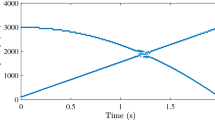Abstract
This paper deals with the problem of signal compression by linearly expanding the signal to be compressed along the elements of an overcomplete dictionary. The compression is obtained by selecting a few elements of the dictionary for the expansion. Therefore, signal description is realized by specifying the selected elements of the dictionary as well as their coefficients in the linear expansion. A crucial issue in this approach is the algorithm for selecting, in correspondence of each realization of the signal, the elements of the dictionary to be used for the expansion. In this paper we consider different possible algorithms for basis selection and compare their performances in a practical case of speech signal.
Access this chapter
Tax calculation will be finalised at checkout
Purchases are for personal use only
Preview
Unable to display preview. Download preview PDF.
Similar content being viewed by others
References
Aase, S., Husoy, J., Skretting, K., Engan, K.: Optimized signal expansions for sparse representation. IEEE Trans. on Signal Processing 49 (2001) 1087–1096
Natarajan, B.: Sparse approximate solutions to linear systems. SIAM J. Computing 24 (1995) 227–234
Rao, B., Delgado, K.: An affine scaling methodology for best basis selection. IEEE Trans. on Signal Processing 47 (1999) 187–200
Vanderbei, R. J.: LOQO user’s manual-version 3.10. Technical Report SOR-97-08, Princeton University, Statistics and Operations Research (1997) Code available at http://www.princeton.edu~rvdb/
Chen, S., Donoho, D., Saunders, M.: Atomic decomposition by basis pursuit. SIAM J. Scientific Computing 20 (1999) 33–61
Coifman, R., Wickerhauser, M.: Entropy-based algorithms for best basis selections. IEEE Trans. on Information Theory 38 (1992) 713–718
Mallat, S., Zhang, Z.: Matching pursuit in a time-frequency dictionary. IEEE Trans. Signal Processing 41 (1993) 3397–3415
Author information
Authors and Affiliations
Editor information
Editors and Affiliations
Rights and permissions
Copyright information
© 2002 Springer-Verlag Berlin Heidelberg
About this paper
Cite this paper
Mattera, D., Palmieri, F., Di Monte, M. (2002). A Comparison of Signal Compression Methods by Sparse Solution of Linear Systems. In: Marinaro, M., Tagliaferri, R. (eds) Neural Nets. WIRN 2002. Lecture Notes in Computer Science, vol 2486. Springer, Berlin, Heidelberg. https://doi.org/10.1007/3-540-45808-5_16
Download citation
DOI: https://doi.org/10.1007/3-540-45808-5_16
Published:
Publisher Name: Springer, Berlin, Heidelberg
Print ISBN: 978-3-540-44265-3
Online ISBN: 978-3-540-45808-1
eBook Packages: Springer Book Archive




